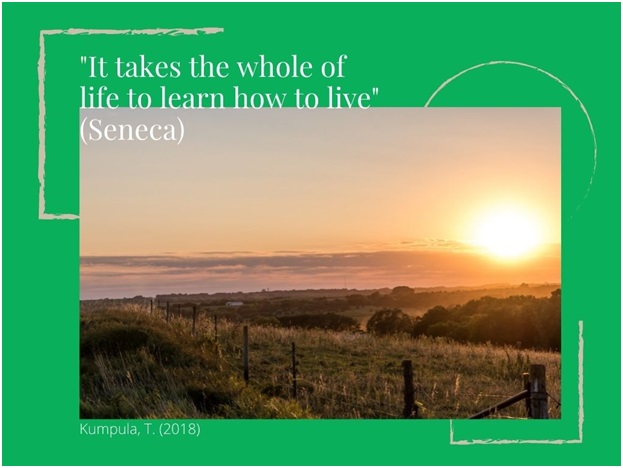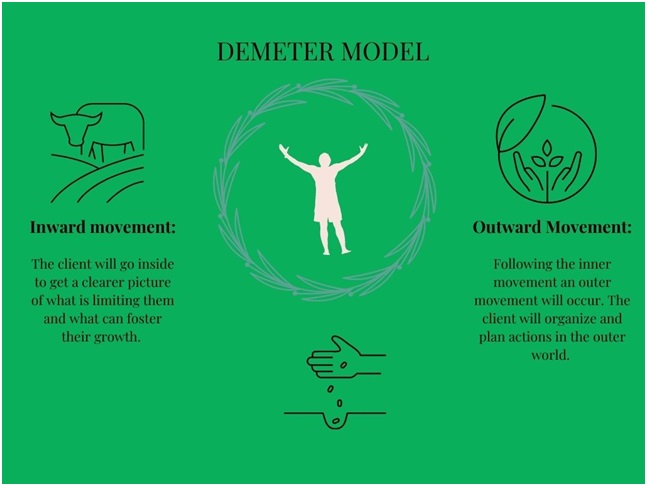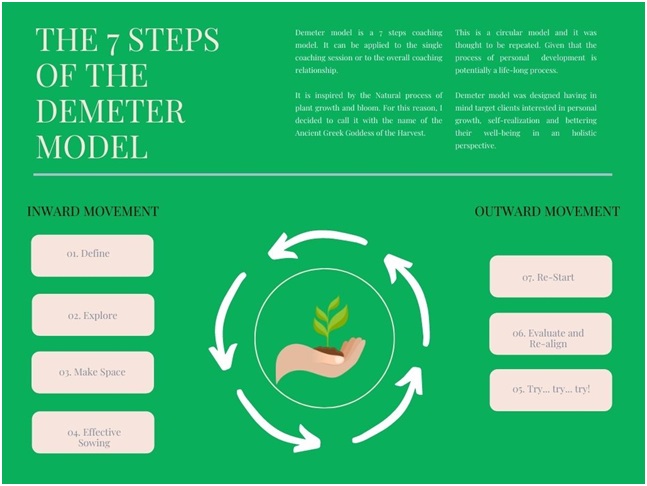A Coaching Model By Annalisa Bracciante, Transformational Coach, ITALY
Demeter: Going Within to Help a Person Bloom on Earth
Demeter is a coaching model that can be applied to a single coaching session or to the overall coaching relationship. It allows the person to move from a starting point of unfulfillment and/or stuckness to a stage of higher contentment and self-realization. This coaching model has been designed, having in mind people in the 30-to-50-year age group, who do not feel completely content in the exclusive satisfaction of their basic needs and in the attainment of material goals or in aiming for hedonistic pleasure but would like to express their full potential, to pursue self-realization and to enjoy a sense of pleasure coming from more meaningful activities.

Underlying Demeter’s coaching model there is the belief that a lasting and consistent transformation in the outer world can be achieved just by an inner awareness and transformation. So, the first phases of this model are devoted to an “inward” movement of exploration and purging of stagnant energies and feelings, stale beliefs, or thought patterns. Only then, the person will be able to focus on their strengths and on their potential for further growth and personal development.
Demeter’s model has been influenced by the Jungian theory of self-actualization, which claims life to be a constant quest for the realization of the individual and their own potential. The theory of self-actualization has been further developed by many other psychologists such as Carl Rogers. This well-known psychologist affirms that the individual has a natural tendency to grow and express their own potential. The fundament of my model, in effect, is the idea that each individual has a natural tendency toward the expression of their individuality and specific gifts since childhood, which, however, could be temporarily hindered or could be blocked by pernicious social conditioning and/or limiting beliefs.

The first step to take in order to proceed in the journey of self-development is undoubtedly looking inwards and taking care of possible self-sabotaging patterns of thoughts, limiting beliefs, and heavy feelings. Next, the coach will support the client in unearthing the precious resources that may be hidden or unrecognized by the client and foster self-esteem expansion by consistent acknowledgments. After this, the coachee will be challenged by the coach to try and go further and fill the gap between the starting point and the arrival point they want to reach. This will be a moment of experimentation and learning by trial and “errors”. “Not everything will go as planned!”, but the results will be worth the efforts. In the following phases, the person will be called to evaluate the outcome of their action and to re-align their behavior in a way that is conscious of the interaction and interrelation between the client and the systems he or she is part of. The last step of the process is a moment of “re-starting”, given that one person’s development is potentially a process that takes a lifetime to be completed.
Concerning the coach’s attitude and practice, the main three features exalted in the Demeter coaching model are the ability to hold a safe space for the client to be able to go inward and then open up freely; the coach’s unconditional acceptance of the client as a bearer of unique life history and precious life experiences; a gentle yet firm attitude of the coach which will challenge the client into action to create momentum and forward motion.
The client-centered, non-directive psychotherapeutic technique of unconditional positive regard, created by Rogers, has been a source of great inspiration for the kind of coaching relationship that I would like to build in my coaching practice and I hope that can be established in an easier way through the Demeter model. In the “ideal” coaching partnership, the coach shows total presence, great respect, and unconditional acceptance of the words of the client, regardless of the kind of feelings (positive or negative) expressed by the client.
Demeter: A Seven Steps Circular Model

In the following paragraphs, the Demeter Coaching Model is described step by step in a deeper way:
1. Defining the Starting Point
In the initial phase, the coach and the client define a clear starting point for their relationship by agreeing on its terms and conditions of it and by stating what their expectations are and what they can offer. In the single session, during the starting point phase, the coachee will be asked by the coach to talk about the following: the general topic the client has in mind, the specific outcome they hope to get from the session, the importance and the meaningfulness of their goal for the session, the measures by which the client will be able to assess their success and what should be addressed in order to work on reaching the goal. The initial phase serves the purpose of clarifying the responsibilities of both parties, their role in the relationship, their expectations, and establishing the proper foundations to proceed.
2. Exploring the Field
Coach and coachee are now walking alongside to find the right spot to sow the seeds of change. They will explore the currents of ideas and beliefs blowing in the coachee’s mind, they will consider the fertilizing properties of values and ideals in the client’s life, and they will look for the well of feelings surfacing during their conversation.
During this phase, the client and the coach will explore the client’s inner world in order to get clarity on potential inner obstacles and available resources for the client’s growth.
3. Making Space or Weeding Out
After the explorative phase, the coach and coachee will be “weeding out” any unfavorable inner element that may cause draining of the person’s energy or a decrease in his or her own self-esteem and sense of agency. The Coach will create a safe space to talk about and address difficult feelings, arising emotions, and limiting beliefs and he or she will facilitate a change in perspective to get the coachee unstuck and to proceed further.
4. Effective Sowing
When the field will be cleared out from any blocking feelings and unfavorable beliefs, the person will have a greater picture of their inner and outer resources, untainted by negative self-judgments. In fact, at this stage, the coachee will have learned to manage more effectively their self-sabotaging thoughts and feelings. Moreover, they will be able to discriminate between what is wheat and what is a weed, between what is a personal asset and what is a personal weakening agent. They will raise their consciousness regarding their strengths and leverage them. Acknowledging and giving unconditional support to the client will be paramount to increasing their self-esteem and trust in their chance to grow strong and blossom. Moreover, the coach will invite the person to employ self-reflective practices, such as journaling and meditation, in between sessions to maximize the effect of the inward motion.
5. Try… try… try!
After the exploration process, the purging phase, and the acknowledgment of one’s strength and resources, the time for experience in the outer world arrives. This is a testing moment and it is a challenging one because the person will have to experience either with their imagination (in the single session) or in the outer world (during the overall coaching relationship) what or who can be an obstacle and what or who can be an ally in the achievement of their goals. At this stage, the coach will be posing more challenging questions coming from their intuition, deep listening of the whole person, and their own experience. The coach will invite the person to go above their usual patterns, to plan, act, and experiment creatively in order to go forward. Now, the coach will challenge the client to create a balanced and sustainable plan of action, which creates momentum and forward motion and will incorporate new ways of action.
6. Evaluate and Realign
The person going through the trial phase brings some concrete action to the table, but will this action be aligned to the complex systems and groups of the clients are part of? In other words, will the planned actions be compatible with the relationship system the client experience in his/her everyday life? Evaluation of the action and further adjustment may be needed to cope with any arising issues connected to the familiar, social, and work environment the client lives in. This specific step in the process was included starting from the awareness that no human being is an “island” we are more of an archipelago of islands floating together in the sea. Therefore, any telluric movement can cause a needed re-adjustment to the whole group. The adjustment phase may bring to the attention of the client new issues to focus on, namely, matters rooted in the relationships clients create with their environment and how they influence their own way of living.
7. Re-Start
Since the growth process is a never-ending development, the Demeter process has been designed to be repeated as many times as needed or desired by the client. This is a “hypothetical” phase and it relies upon the will of the client to proceed towards new goals and aims.
Learn How to Create Your Own Coaching Model
Your Coaching Model reflects your values,
philosophies and beliefs and must communicate who you will coach
and the problems you will solve. Read more about creating your coaching model
References
Cherry, K. (2020), Carl Rogers Psychologist Biography. (Accessed 9 January 2022).
Cherry, K. (2022) Maslow’s Hierarchy of Needs. (Accessed 9 January 2022).
Farah, S. (2013) The Individuation Project: a Jungian journey to self-actualization. (Accessed 12 December 2021).
Grenville-Cleave, B. (2016) Positive Psychology: a toolkit for happiness, purpose, and well-being, UK: Icon Books Ltd.
Jacobson, S. (2018) What is Individuation? Carl Jung and the Journey of Self. (Accessed 12 December 2021).
Kumpula T. (2018), Field of Green Grass. (Accessed: 19 April 2022).
Northe, S. I. (2019) Find your True North. Awaken to the pure winder of transformational coaching, Librotas.
Rock, D. and Page, L. J. (2009) Coaching with the brain in mind: foundations for practice, John Wiley and Sons Inc.
Seligman, M. E. P. (2012) Flourish a visionary new understanding of happiness and well-being, New York: Free Press.
Seneca, L. A. (1993) La brevità della vita, translated by Alfonso Traina, Milano: Rizzoli.
Vanderpol, L. (2019) A shift in Being. The art and practices of deep transformational coaching, Imaginal Light Publishing.